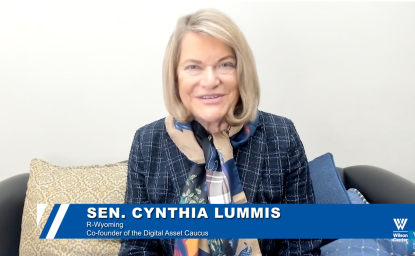Introduction
In ancient Greece, an oracle was a person who was considered to provide wise counsel and prophetic predictions. The most famous of these, the Oracle of Delphi, was believed to deliver prophecies from the Greek god Apollo. Her advice was sought after by lawmakers and commoners alike. While you are unlikely to find a Greek god roaming around the blockchain, you have likely interacted with a modern-day oracle if you have transacted on-chain. Blockchain oracles are data feeds that source, verify, and transmit external information to smart contracts running on the blockchain. In the world of decentralized finance (DeFi), oracles play a crucial role. They serve as both inbound and outbound bridges for data shared between blockchains and the outside world. There are hundreds of DeFi protocols but only a handful of meaningfully large blockchain data oracle providers, with Chainlink accounting for 84% of the total $4.8B market cap of the category. While historically reliable, this relative centralization opens an attack vector against a potential single point of failure.
That said, a new wave of DeFi protocols is challenging this paradigm with architectures that forego the use of oracles. These lending and derivatives protocols feature novel architectures with their own opportunities and trade-offs.
By the end of this article, you will have a better understanding of crypto data oracles, oracle-free protocols, DeFi-based peer-to-peer lending, and the benefits and risks to end users. Most importantly, we will extract key takeaways for policymakers who face the challenge of protecting consumers without stifling innovation in this still nascent and quickly evolving DeFi space.
Understanding Crypto Oracles
Before delving into oracle-free protocols, it is essential to understand what is a crypto oracle.
A blockchain data oracle is an information data source from the outside world used for smart contracts that require such data. Smart contracts are automated digital agreements that execute when certain conditions are met. Blockchains like Ethereum are deterministic, meaning the same input always produces the same output. This makes using smart contracts with external data complex. If blockchains use external data, the nodes (network participants) could reach conflicting conclusions, disrupting the blockchain's integrity. For instance, a smart contract using a fluctuating exchange rate could produce different results at different times.
Oracles address this challenge by regularly importing external data onto the blockchain for use by smart contracts. There are a variety of data feeds available, ranging from price feeds for commodities, stocks, and cryptocurrencies to real-time weather data.
Data Availability and Recency
Let’s break down how often data is imported, how it is stored, and how it’s referenced.
Frequency of Updates: Oracles can provide real-time data or update at specified intervals, depending on the use case and capabilities of the blockchain a protocol is built on.
-
Real-Time Updates: Some oracles are designed to fetch and update data in real-time, especially when market prices or other rapidly changing data are involved.
-
Scheduled Intervals: Other oracles might update data at regular intervals, such as hourly or daily, which can be more suitable for less volatile data sources.
-
Event-Driven Updates: Certain oracles update only when specific events occur outside the blockchain, ensuring efficient use of resources.
-
Manual Updates: In some cases, especially where human judgment is required, oracles might be updated manually.
Data History: Each update is recorded on the blockchain, creating a transparent history of all past values.
Consistency: All nodes use the most recent data, ensuring network-wide consensus.
Smart Contract Interaction: While the blockchain retains all data points, smart contracts typically reference the latest value provided by the oracle.
Unlocking the Full Potential of Blockchain with Oracles
Now that we have a high-level understanding of how data is stored and the frequency at which it can be imported, let’s dive into some of the exciting use cases that oracles enable.
Dynamic Financial Products: Oracles empower the DeFi space to craft advanced financial instruments, such as derivatives anchored to real-world stock prices or insurance policies that automatically compensate farmers when rainfall data indicates drought conditions.
Decentralized Identity Systems: Leveraging trusted data from oracles, decentralized identity verification systems enhance security by eliminating centralized points of vulnerability. They promote accessibility by allowing seamless validation of personal credentials without relying on a centralized entity. These systems can help foster trust as individuals gain greater autonomy and control over their personal data.
Real-World Governance: With oracles, blockchain systems can be used for decentralized voting on real-world matters. For instance, a community could vote on local initiatives based on real-time data feeds about community developments. In conjunction with decentralized identity systems, this can have the potential to expand voting access while minimizing fraud and security.
Supply Chain Verification: Oracles allow blockchains to track and verify real-world goods as they move through a supply chain. By pulling data from sensors, GPS devices, and other tracking mechanisms, blockchain can provide immutable, transparent records of goods from production to delivery.
Automated Compliance: In sectors where regulatory compliance is crucial, oracles can fetch real-time data to ensure that blockchain operations remain within legal parameters. For instance, a DeFi platform could use an oracle to ensure its operations align with current interest rate regulations.
Event-Driven Actions: Oracles enable smart contracts to execute actions based on real-world events. This could range from sports betting platforms settling bets based on actual match outcomes to entertainment contracts disbursing royalties when a song reaches a certain number of plays.
Enhanced Gaming and Virtual Worlds: Within blockchain gaming and immersive virtual realities, oracles can incorporate real-world data to dictate in-game scenarios. Envision a virtual city-building game where real-world urban development trends and policies influence city growth and challenges.
IoT Integration: Through oracles, smart contracts can seamlessly interface with data from IoT devices. This integration unlocks transformative solutions in domains like smart agriculture, urban planning with smart cities, environmental monitoring, smart water management strategies, and robust logistics and supply chain management.
Improved Healthcare Security and Efficiency: Leveraging oracles, medical data can be securely transitioned from off-chain sources to on-chain repositories. This not only ensures the confidentiality of sensitive health information but also paves the way for more integrated, transparent, and efficient healthcare systems
Essentially, oracles act as bridges between the blockchain and the outside world, enabling interaction with external data while preserving the blockchain's integrity. By facilitating these interactions, oracles are not just enhancing the capabilities of existing blockchain applications but also paving the way for entirely new and entirely novel applications.
The Traditional Oracle-Reliant Protocols
DeFi protocols that offer leverage via spot lending markets or derivative instruments use oracles to determine when a position should be liquidated or the outcome of a derivative contract. This has several drawbacks.
Lending Protocols: Eligible collateral is restricted to assets that have reliable oracle price feeds. Loan parameters such as the loan-to-value ratio are governed by the protocol. As a result, any bad debt incurred becomes the responsibility of the protocol rather than its individual lenders.
Derivatives Protocols: These lack internal price discovery mechanisms and are susceptible to lagged price updates, severely limiting their scale and user experience.
Protocol Agnostic: Oracles create a significant attack vector for DeFi protocols. Although protocol safety is generally assumed to be inherited from the protocol’s underlying smart contract network, it also relies on a properly functioning oracle to provide accurate pricing data. This can be exploited by an “oracle manipulation attack”, typically carried out against a DeFi protocol in the following way: The attacker uses a large amount of capital, often sourced through a flash loan, to increase the trading volume on a low-liquidity token. This leads to a significant price increase in the token not reflective of the wider market. After the price of the token has been inflated, the attacker either exchanges their artificially inflated holdings for tokens with higher liquidity, or uses their holdings as collateral to borrow assets, never to be repaid.
Oracle Manipulation Attacks are on the Rise
It is important to note that not all oracles, or their respective protocols are created equal. The largest oracle provider, Chainlink, has not been the cause of a major attack. Unfortunately, the end user is rarely privy to which oracle a protocol is leveraging.
The Emergence of Oracle-Free Protocols
Oracle-free protocols are a new breed of DeFi protocols that aim to eliminate the need for oracles. They are reimagining the architecture for lending and derivatives protocols, with the core design change being a lack of reliance on oracles. These protocols fall into two general categories: peer-to-peer lending and hybrid protocols built on automated market makers (AMMs). In this article, we will focus on peer-to-peer lending protocols.
Peer-to-Peer Lending Protocols
In peer-to-peer lending protocols, the responsibility of pricing and underwriting loans shifts from the protocol to the user. Lenders can set their own interest rates and acceptable loan-to-value ratios. This creates a loan order book similar to those available on centralized exchanges. By eliminating the need for oracles in the protocol's design, these loans can be generated using any on-chain collateral. The risk of non-repayment is transferred from the protocol to the individual user and allows for loans to be made against a wider variety of crypto assets.
The peer-to-peer model allows for more customization of loans, but this comes at the cost of ease of use. To ensure that the liquidity provided is used effectively, users must actively manage their positions. Experienced users or external protocols managing these positions often rely on prices from oracles elsewhere to decide when to adjust a position, effectively bringing oracle risk back into play.
Comparing Crypto Lending to Traditional Peer-to-Peer Lending Platforms
When compared to traditional peer-to-peer lending platforms, several key differences emerge that highlight the unique benefits and drawbacks of each system.
Traditional peer-to-peer lending platforms connect borrowers and lenders directly, bypassing the need for a traditional financial institution.
Advantages include:
-
Potentially lower interest rates for borrowers
-
Higher returns for lenders
-
Increased loan personalization
However, drawbacks exist:
Crypto lending operates on a similar peer-to-peer model but uses cryptocurrencies as the medium of exchange. This affords several advantages, including the ability to use a range of digital assets as collateral. Oracle-free protocols can offer a wider range of digital asset collateral options, as they are not limited to assets with reliable oracle price feeds. The popular NFT marketplace, BLUR, is a notable example of this. Users on BLUR can borrow funds using their NFTs as collateral. Max borrow rates are dictated by the floor price of the collection on the marketplace. Loan interest rates are set by the users providing funds to borrow.
Another advantage of crypto lending – the permissionless nature of crypto afforded by smart contracts and the lack of credit check requirements for collateralized lending increases the speed and accessibility of obtaining a loan. This is an attractive proposition to several user types: the underbanked who may have difficulty obtaining loans via traditional institutions, users who are able to provide loan collateral who do not want to incur the negative credit score impact of a credit check, or users who need to obtain funds quickly.
Other advantages include the fact that lenders and borrowers can set and agree to rates of their choosing, and that auditable smart contracts can help users avoid the pitfalls of off-chain collateralized predatory lending. This alternative lending mechanism can increase the availability of capital to individual consumers, which could spur economic activity and capital expenditure.
Crypto lending is not without drawbacks. High crypto market volatility can lead to rapid changes in the value of non-stablecoin collateral, which can lead to frequent margin calls or even automatic liquidation of the loan. It can be challenging for users who wish to convert their loans into fiat currency, as many banks will decline interactions with crypto platforms. Users may also struggle with DeFi’s relative lack of guardrails, which could result in uneducated users permanently losing access to funds. Users leveraging oracle-free protocols must also actively manage their positions to ensure their liquidity is being used productively.
Key Takeaways for US Policymakers
As the DeFi landscape continues to evolve, it's crucial for US policymakers to understand the implications of these developments and to adapt regulatory frameworks accordingly. The key takeaways are as follows:
Centralization Risk: Data oracles are a crucial component of the underlying infrastructure of DeFi. The current concentration of providers creates an attack vector with the potential for system risk. Policymakers should consider ways to foster investment, diversification, and transparency in this underlying infrastructure to help strengthen the system.
Increased Economic Opportunity: Although the country has been burned by the false promises of positive economic impact by centralized crypto actors, truly decentralized solutions are poised to deliver. Crypto peer-to-peer lending platforms increase the speed and accessibility at which individual consumers can provide and acquire loans. This fills a gap in the traditional financial system and has the potential to spur new economic activity. Additionally, the innovations made possible by blockchain and data oracles in IoT, healthcare, real estate, and telecom have the potential to create new high-wage jobs and spur further innovation. Legislation focusing on increasing compatibility with existing systems like fiat on-ramps and healthcare databases could unlock this innovation.
Consumer Education: Regulating DeFi presents unique challenges due to its decentralized nature. Rules cannot be applied to automated protocols in the same way they are applied to centralized entities. DeFi increases accessibility and flexibility in regard to lending, but this comes at the expense of the guardrails that exist with traditional financial institutions. While there are resources for troubleshooting issues, there is no customer service in DeFi. If a user is not careful, there are a multitude of ways they can lose their funds without any recourse for recovery. Peer-to-peer lending in DeFi is the most prominent example of the accessibility/guardrails tradeoff. An emphasis on consumer education will ensure that consumers can make informed decisions and manage risk when leveraging these protocols.
In conclusion, while both traditional peer-to-peer lending and crypto lending offer unique advantages, they also come with their own set of challenges. As the crypto lending space continues to evolve it will be interesting to see how these challenges are addressed and how the landscape changes in response to these innovations. Policymakers play a crucial role in this evolution, and it's critical that they remain informed and proactive in their approach.








